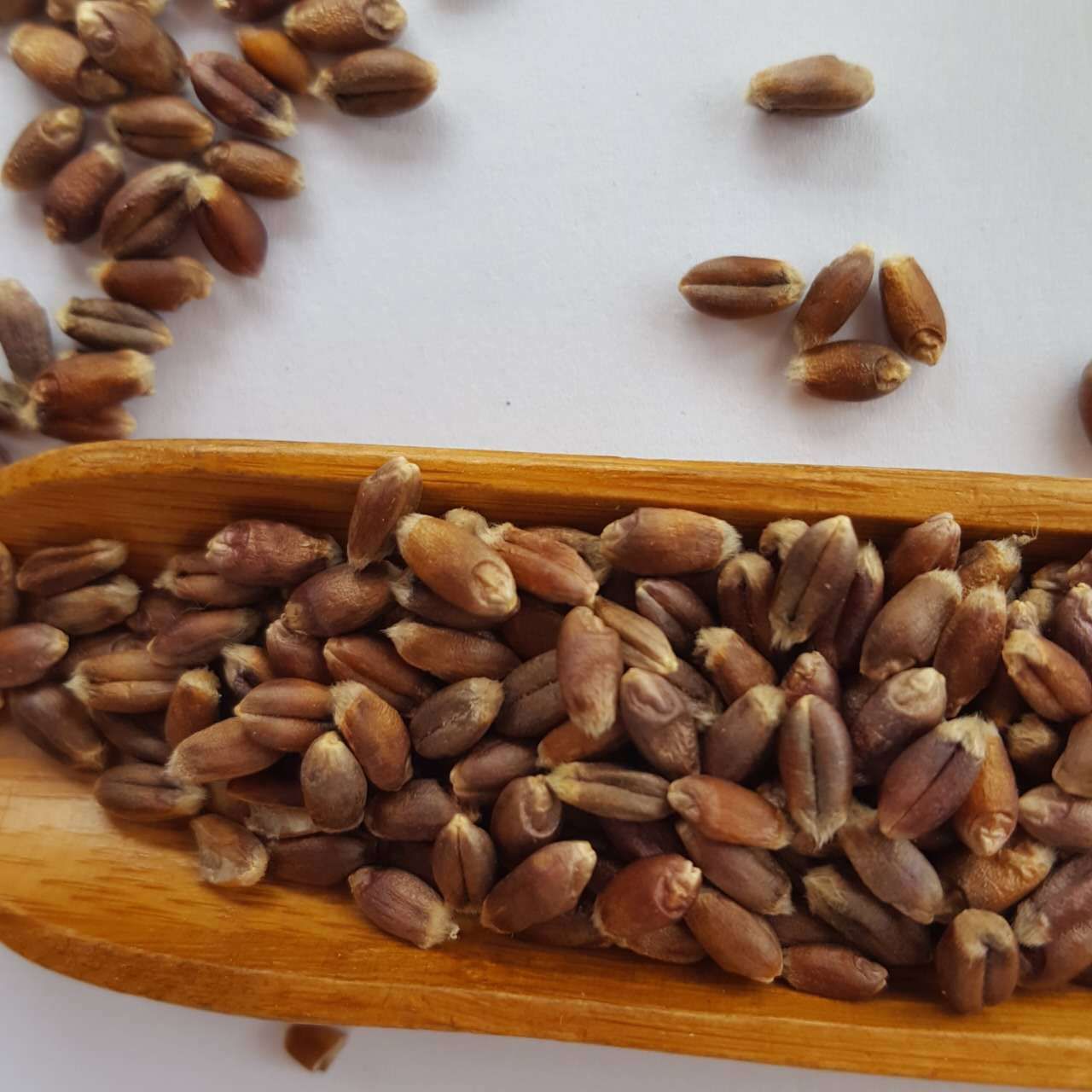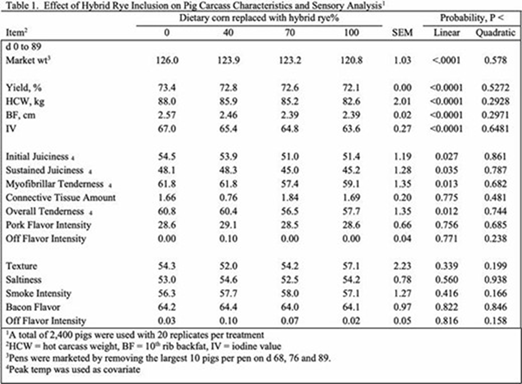Caitlyn R Sullivan, Robert C Thaler, Kiah M Berg, Jon A De Jong, Joe P Ward, Paul F Frahm, Mike J Boerboom
 The objective of
this trial was to determine the effects of hybrid rye (KWS Bono) inclusion rate
on lean muscle deposition and product quality of grow-finish pigs. A total of
2,400 barrows and gilts (FAST x PIC 800, 44.9 kg) were randomly allotted to 1
of 4 dietary treatments. Diets were corn-soybean based
with hybrid rye replacing either 0, 40, 70 or 100% of the corn in the diet. All
diets were formulated to meet or exceed the 2012 NRC requirements for all
nutrients, and a five-phase feeding program was utilized (44.9 to 56.0, 56.0 to
69.0, 69.0 to 87.9, 87.9 to 107.5, and 107.5 to 111.6 kg). Pigs were weighed
and feed disappearance measured at each phase change. Pigs were marketed across
three events and (%) Yield, Hot Carcass Weight (HCW), Backfat (BF) and Iodine
Value (IV) were measured at the procurement facility. Two primal sections
(loins and bellies) were removed from 88 pigs (22/treatment) and sent to the
KSU Meat Lab Facility to be cooked or smoked for a trained, sensory panel
evaluation. Data were analyzed using the GLIMMIX procedure of SAS, with block
as a random effect and pre-planned linear and quadratic contrast statements to
analyze the inclusion of hybrid rye. Results indicate that increasing hybrid
rye inclusion rate from 0 to 100% decreased (P < 0.001) average market BW, % Yield, HCW, BF and IV all decreased (P < 0.001) as hybrid rye inclusion rate increased (Table 1). The sensory measures for loin chops for Initial Juiciness, Sustained Juiciness, Myofibrillar Tenderness and Overall Tenderness decreased (P < 0.05) with increasing hybrid rye. Connective
Tissue Amount, Pork-Flavor Intensity and Off-Flavor Intensity were not affected
(P > 0.10) by dietary treatment. All bacon measures including Texture,
Saltiness, Smoke Intensity, Bacon Flavor and Off Flavor were not affected by
hybrid rye inclusion (P > 0.10). In summary, while there was a reduction in
HCW, BF, % Yield, IV and certain sensory values for loins as hybrid rye
increased, there was no effect on any of the bacon variables measured. Therefore,
depending on economics, hybrid rye can be an acceptable replacement for corn in
finishing pig diets.
The objective of
this trial was to determine the effects of hybrid rye (KWS Bono) inclusion rate
on lean muscle deposition and product quality of grow-finish pigs. A total of
2,400 barrows and gilts (FAST x PIC 800, 44.9 kg) were randomly allotted to 1
of 4 dietary treatments. Diets were corn-soybean based
with hybrid rye replacing either 0, 40, 70 or 100% of the corn in the diet. All
diets were formulated to meet or exceed the 2012 NRC requirements for all
nutrients, and a five-phase feeding program was utilized (44.9 to 56.0, 56.0 to
69.0, 69.0 to 87.9, 87.9 to 107.5, and 107.5 to 111.6 kg). Pigs were weighed
and feed disappearance measured at each phase change. Pigs were marketed across
three events and (%) Yield, Hot Carcass Weight (HCW), Backfat (BF) and Iodine
Value (IV) were measured at the procurement facility. Two primal sections
(loins and bellies) were removed from 88 pigs (22/treatment) and sent to the
KSU Meat Lab Facility to be cooked or smoked for a trained, sensory panel
evaluation. Data were analyzed using the GLIMMIX procedure of SAS, with block
as a random effect and pre-planned linear and quadratic contrast statements to
analyze the inclusion of hybrid rye. Results indicate that increasing hybrid
rye inclusion rate from 0 to 100% decreased (P < 0.001) average market BW, % Yield, HCW, BF and IV all decreased (P < 0.001) as hybrid rye inclusion rate increased (Table 1). The sensory measures for loin chops for Initial Juiciness, Sustained Juiciness, Myofibrillar Tenderness and Overall Tenderness decreased (P < 0.05) with increasing hybrid rye. Connective
Tissue Amount, Pork-Flavor Intensity and Off-Flavor Intensity were not affected
(P > 0.10) by dietary treatment. All bacon measures including Texture,
Saltiness, Smoke Intensity, Bacon Flavor and Off Flavor were not affected by
hybrid rye inclusion (P > 0.10). In summary, while there was a reduction in
HCW, BF, % Yield, IV and certain sensory values for loins as hybrid rye
increased, there was no effect on any of the bacon variables measured. Therefore,
depending on economics, hybrid rye can be an acceptable replacement for corn in
finishing pig diets.

Journal of Animal Science, Volume 101, Issue Supplement_2, November 2023, Pages 28–29, https://doi.org/10.1093/jas/skad341.032
Registration hotline: 021-57634675
fax: 021-57632800
Copy right : 上海亘泰实业集团
Collaboration & Sponsorship: 021-57634938 57631012
ASASHotline:021-67868428
Site Map | CNZZStatistics
address:Shanghai songjiang jiuting town nine new highway 90 lane 3 nine new commercial building 15 floor

WeChat ID:asaschina
The pig nutrition international BBS CSIS